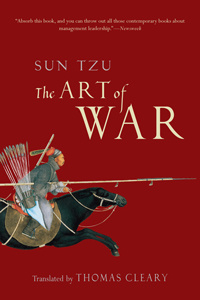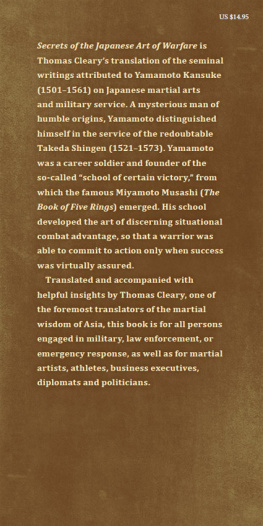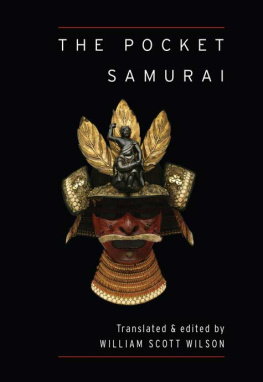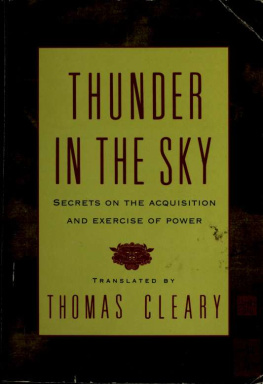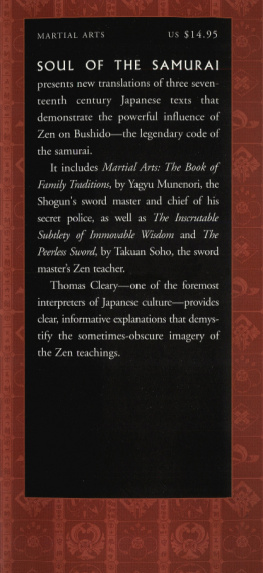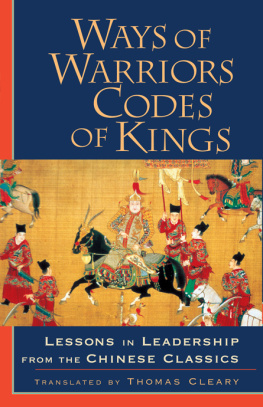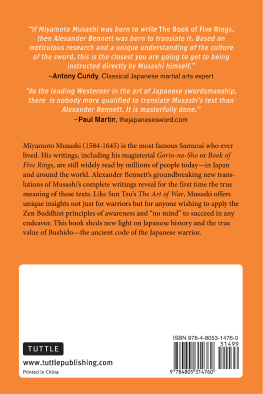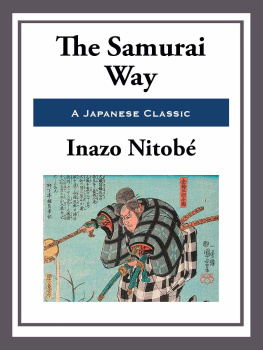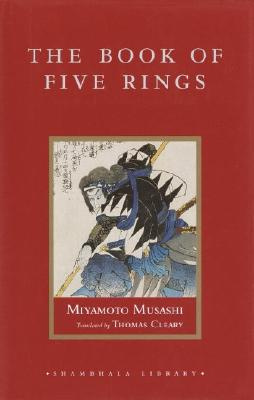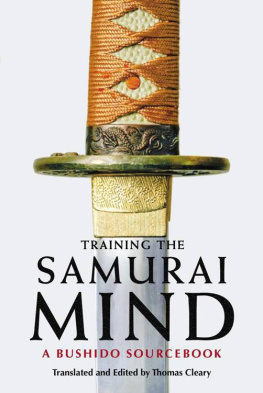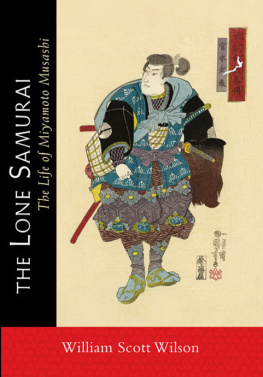Cleary Thomas F. - The Book of Five Rings
Here you can read online Cleary Thomas F. - The Book of Five Rings full text of the book (entire story) in english for free. Download pdf and epub, get meaning, cover and reviews about this ebook. City: London;Boston;Mass;Japan, year: 2005, publisher: Shambhala Publications, genre: Children. Description of the work, (preface) as well as reviews are available. Best literature library LitArk.com created for fans of good reading and offers a wide selection of genres:
Romance novel
Science fiction
Adventure
Detective
Science
History
Home and family
Prose
Art
Politics
Computer
Non-fiction
Religion
Business
Children
Humor
Choose a favorite category and find really read worthwhile books. Enjoy immersion in the world of imagination, feel the emotions of the characters or learn something new for yourself, make an fascinating discovery.
- Book:The Book of Five Rings
- Author:
- Publisher:Shambhala Publications
- Genre:
- Year:2005
- City:London;Boston;Mass;Japan
- Rating:5 / 5
- Favourites:Add to favourites
- Your mark:
- 100
- 1
- 2
- 3
- 4
- 5
The Book of Five Rings: summary, description and annotation
We offer to read an annotation, description, summary or preface (depends on what the author of the book "The Book of Five Rings" wrote himself). If you haven't found the necessary information about the book — write in the comments, we will try to find it.
The Book of Five Rings — read online for free the complete book (whole text) full work
Below is the text of the book, divided by pages. System saving the place of the last page read, allows you to conveniently read the book "The Book of Five Rings" online for free, without having to search again every time where you left off. Put a bookmark, and you can go to the page where you finished reading at any time.
Font size:
Interval:
Bookmark:
The Book of Five Rings

Miyamoto Musashi
TRANSLATED FROM THE JAPANESE BY
Thomas Cleary
INCLUDING
The Book of Family Traditions on the Art of War
by Yagy Munenori

SHAMBHALA
Boston & London
2011
SHAMBHALA PUBLICATIONS, INC.
Horticultural Hall
300 Massachusetts Avenue
Boston, Massachusetts 02115
www.shambhala.com
1993 by Thomas Cleary
All rights reserved. No part of this book may be reproduced in any form or by any means, electronic or mechanical, including photocopying, recording, or by any information storage and retrieval system, without permission in writing from the publisher.
eISBN 978-0-8348-2178-1
ISBN 978-1-59030-248-4
Contents
T HE JAPANESE WORD shin-ken means real sword, but it is now more generally used in a metaphorical sense. In common parlance, to do something with a real sword means to do it with utmost earnestness. To have an attitude proper to a real sword means to be deadly serious. Shin-ken sh-bu, literally a contest with real swords, means something done in deadly earnest.
This molecule of linguistic anthropology hints at a very good reason why the Japanese are as persistent and skilled as they are at survival and adaptation. Through centuries of cultural training under the martial rule of the samurai, the Japanese are generally able to experience and address virtually anything as a life and death situation.
This book shows how they do it.
T he Book of Five Rings and The Book of Family Traditions on the Art of War are two of the most important texts on conflict and strategy emerging from the Japanese warrior culture. Originally written not only for men-at-arms, they are explicitly intended to symbolize processes of struggle and mastery in all concerns and walks of life.
The Book of Five Rings was written in 1643 by Miyamoto Musashi, undefeated dueler, masterless samurai, and independent teacher. The Book of Family Traditions on the Art of War was written in 1632 by Yagy Munenori, victorious warrior, mentor of the Shgun, and head of the Secret Service.
Both authors were professional men-at-arms born into a long tradition of martial culture that had ultimately come to dominate the entire body of Japanese polity and society. Their writings are relevant not only to members of the ruling military caste, but also to leaders in other professions, as well as people in search of individual mastery in whatever their chosen path.
The Book of Five Rings and The Book of Family Traditions on the Art of War are both written in Japanese, rather than the literary Chinese customary in elite bureaucratic, religious, and intellectual circles in Japan at that time. The Japanese in which they are written, furthermore, is relatively uncomplicated and quite free of the subtle complexities of classical high court Japanese. Although the crudity of Musashis syntax and morphology make for clumsy reading, nevertheless the basic simplicity and deliberate clarity of both works make them accessible to a wide and varied audience.
The rise and empowerment of the samurai class in Japan may be seen in the two terms used to refer to its members, samurai and bushi. The word samurai comes from the Japanese verb saburau, which means to serve as an attendant. The word bushi is Sino-Japanese and means armed gentry. The word samurai was used by other social classes, while the warriors referred to themselves by the more dignified term bushi.
The original samurai were attendants of nobles. In time their functions expanded to the administration, policing, and defense of the vast estates of the nobles, who were mostly absentee landlords. Eventually the samurai demanded and won a greater share of the wealth and political power that the nobles had called their own. Ultimately the military paragovernment of the Shguns, known as the Bakufu, or Tent Government, overshadowed the imperial organization and dominated the whole country.
Musashi and Yagy lived in the founding era of the third Tent Government, which lasted from the beginning of the seventeenth century through the middle of the nineteenth century. While inheriting the martial traditions of its predecessors, this third Tent Government differed notably in certain respects.
The first Tent Government was established in eastern Japan near the end of the twelfth century and lasted for nearly one hundred and fifty years. The warriors of this time were descendants of noble houses, many of whom had honed their martial skills for generations in warfare against the Ainu people in eastern Japan. As the Tent Government was seated in Kamakura, a small town near modern Tky, this period of Japanese history is commonly called the Kamakura era.
The second Tent Government supplanted the first in 1338. The warrior class had expanded and become more differentiated by this time, with lesser and thinner genealogical ties to the ancient aristocracy. The Shguns of this period established their Tent Government in Kyto, the old imperial capital, and tried to establish high culture among the new samurai elite. This period of Japanese history is commonly called the Ashikaga era, after the surname of the Shguns, or the Muromachi era, after the name of the outlying district of Kyto in which the Tent Government was located.
To understand Japanese history and culture, it is essential to realize that no government ever united the whole country until the Meiji Restoration of 1868. The imperial government had always ruled the whole land in theory, but never in fact. The imperial house had never really been more than a center of powerful factions, competing with other powerful factions. Even when everyone recognized the ritual and political status of the emperor in theory, direct imperial rule only reached a portion of the land.
As this is true of the imperial house, so it is also true of the military governments. The reign of the Shguns was always complicated and mitigated by the very nature of the overall Japanese power structure. The rule of the Kamakura Tent Government was not absolute, that of the Muromachi Tent Government even less. Separatism, rivalry, and civil warfare marked the fifteenth and sixteenth centuries.
By this time, known as the era of the Warring States, the way of war was open to anyone who could obtain arms by any means. Lower-class samurai rose up to overthrow the upper-class samurai, and Japan was plunged into chaos. It was not until the latter part of the sixteenth century that a series of hegemons emerged with strategy and power sufficient to move dramatically toward unification. The third Tent Government was built on the achievements of those hegemons.
Within the context of traditional Japanese society, the founder of the third Shogunate was an upstart and a usurper. Aware of this, he set out to establish a most elaborate system of checks and controls to ensure the impossibility of such an event ever occurring again. Moving his capital again to eastern Japan, away from the heartland of the ancient aristocracy and imperial regime, the new Shgun disarmed the peasants and disenfranchised the samurai class, removing all warriors from the land and settling them in castle towns. This period of Japanese history is commonly known as the Tokugawa era, after the surname of the Shguns, or the Edo period, after the name of the new capital city, now called Tky.
Tokugawa Japan was divided into more than two hundred baronies, which were classified according to their relationship to the Tokugawa clan. The barons were controlled by a number of methods, including regulation of marriage and successorship, movement of territories, and an elaborate hostage system. The baronies were obliged to minimize their contingents of warriors, resulting in a large number of unemployed samurai known as
Next pageFont size:
Interval:
Bookmark:
Similar books «The Book of Five Rings»
Look at similar books to The Book of Five Rings. We have selected literature similar in name and meaning in the hope of providing readers with more options to find new, interesting, not yet read works.
Discussion, reviews of the book The Book of Five Rings and just readers' own opinions. Leave your comments, write what you think about the work, its meaning or the main characters. Specify what exactly you liked and what you didn't like, and why you think so.

